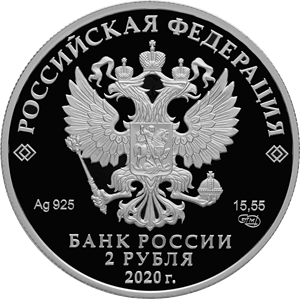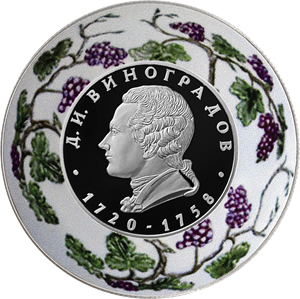Creator of Russian porcelain D.I. Vinogradov – 300th Anniversary of his Birth (1720)
Obverse
the mirror field of the disc bears a relief image of the National Coat of Arms of the Russian Federation, over it along the rim there is the semicircular inscription ‘РОССИЙСКАЯ ФЕДЕРАЦИЯ’ (RUSSIAN FEDERATION) framed on both sides by doubled rhombuses, below under the coat of arms there are indications of the precious metal and its fineness on the left and the fine metal content and the mint trade mark on the right, at the bottom in the centre, in three lines, there is an inscription ‘БАНК РОССИИ’ (BANK OF RUSSIA), the denomination of the coin ‘2 РУБЛЯ’ (2 RUBLES), and the year of issue ‘2020 г.’ (2020).
Reverse
the mirror field of the disc features a relief profile of D.I. Vinogradov in the centre; the inscription above along the inner rim reads ‘Д.И. ВИНОГРАДОВ’ (D.I. VINOGRADOV), the inscription below indicates the master’s life years ‘1720–1758’; the coloured outer ring of the coin is adorned with the rambling vine pattern used by Vinogradov to decorate one of his bowls.
Authors
Designer: E.V. Kramskaya (obverse, reverse).
Sculptors: A.A. Dolgopolova (obverse), A.N. Bessonov (reverse).
Mint: Saint Petersburg Mint (СПМД).
Edge: 195 corrugations.
Discover more
Dmitry Vinogradov (1720-1758) was a Russian scientist and the founder of porcelain production in Russia.
In 1744, Russian Empress Elizabeth ordered the founding of the Neva Porcelain Manufactory (in 1765, it became the Imperial Porcelain Factory) to discover the secret of porcelain manufacture, which at that time was known only in China and Saxony. Dmitry Vinogradov, who had just returned from Germany, where he studied mining and metallurgy, as well as chemistry and physics, came to work in the factory and became a student of the foreign master Christoph Hunger.
During his period of training, Vinogradov engaged in the active research of raw materials, sought the optimal composition of a porcelain mix, developed various recipes for porcelain enamel and tested different firing methods. In 1747, his hard work resulted in the production of the first sample of Russian porcelain.
In 1748, after Hunger was dismissed because of his incompetence, Vinogradov was named head of the factory and turned his attention to the manufacturing process. As a result of very many tests, Vinogradov managed to achieve a quality of porcelain equal to the best European examples. The factory began the production of porcelain pieces for the Imperial Court, such as snuffboxes, inkpots, candleholders and the like. However, Vinogradov did not achieve wide recognition, as, for the purpose of preserving the secrecy of his porcelain recipe, he was virtually kept inside the factory, where he died in complete obscurity. Very few pieces made personally by him have survived to the present.


